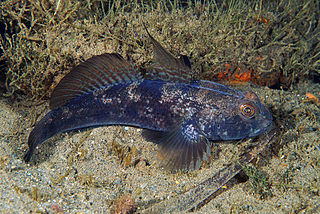
Gobiidae is a family of bony fish in the order Gobiiformes, one of the largest fish families comprising more than 2,000 species in more than 200 genera, sometimes referred to as the "true gobies". Most of them are relatively small, typically less than 10 cm (3.9 in) in length. The Gobiidae includes some of the smallest vertebrates in the world, such as Trimmatom nanus and Pandaka pygmaea, Trimmatom nanus are under 1 cm long when fully grown, then Pandaka pygmaea standard length are 9mm (0.35 in),maximum known standard length are 11 mm (0.43 in). Some large gobies can reach over 30 cm (0.98 ft) in length, but that is exceptional. Generally, they are benthic, or bottom-dwellers. Although few are important as food for humans, they are of great significance as prey species for commercially important fish such as cod, haddock, sea bass, and flatfish. Several gobiids are also of interest as aquarium fish, such as the dartfish of the genus Ptereleotris. Phylogenetic relationships of gobiids have been studied using molecular data.
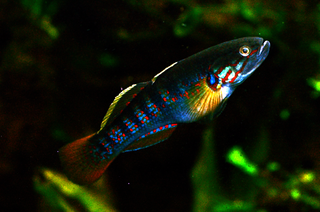
Eleotridae is a family of fish commonly known as sleeper gobies, with about 34 genera and 180 species. Most species are found in the tropical Indo-Pacific region, but there are also species in subtropical and temperate regions, warmer parts of the Americas and near the Atlantic coast in Africa. While many eleotrids pass through a planktonic stage in the sea and some spend their entire lives in the sea; as adults, the majority live in freshwater streams and brackish water. One of its genera, Caecieleotris, is troglobitic. They are especially important as predators in the freshwater stream ecosystems on oceanic islands such as New Zealand and Hawaii that otherwise lack the predatory fish families typical of nearby continents, such as catfish. Anatomically, they are similar to the gobies (Gobiidae), though unlike the majority of gobies, they do not have a pelvic sucker.

Gobius is a genus of fish in the family Gobiidae native to fresh, brackish and marine waters of and around Europe, Africa and Asia. It contains the typical gobies, being the type genus of the formerly recognised subfamily Gobiinae and family and the namesake genus of its order Gobiiformes.

Knipowitschia is a genus of marine, fresh and brackish water gobies native to Eurasia. The genus name almost certainly honours Nikolai Mikhailovich Knipovich (1862-1938), a biologist who led a number of expeditions to the Caspian Sea.

Neogobius is a genus of goby native to Black Sea and the Caspian Sea basins. It is part of the broader Benthophilinae subfamily which is also endemic to the same region. Nevertheless, two Neogobius species have recently turned out to be highly invasive and spread across Europe and even to the Great Lakes of North America.

Pomatoschistus is a genus of gobies native to fresh, brackish and marine waters of Europe, the eastern Atlantic Ocean and the Mediterranean Sea.

The giant goby is a species of goby native to coastal marine and brackish waters of the eastern Atlantic, the Mediterranean Sea and the Black Sea at depths of from 10 to 35 metres. This species is of minor importance to commercial fisheries and is also popular as a game fish.

Ponticola is a genus of gobies native mostly to fresh waters of the Black Sea - Caspian Sea region in Eurasia. Some species occur in the brackish-water Black and Caspian seas themselves. It was considered to be part of the broader goby subfamily Benthophilinae, also endemic to the same region, although the 5th edition of Fishes of the World does not list any subfamilies in the Gobiidae. Originally, Ponticola was described as subgenus of Neogobius.

The tadpole-gobies (Benthophilus), also called pugolovkas, are a genus of Ponto-Caspian fishes in the family Gobiidae.

The grass goby is a species of goby native to the Mediterranean Sea, the Sea of Azov and the Black Sea. It is currently the only known member of its genus.
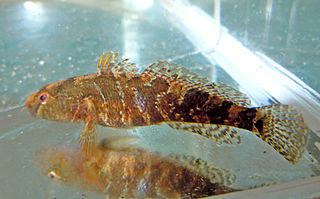
Proterorhinus is a genus of fishes, known as the tubenose gobies. These gobiid fish are native to Eurasia where they occur in the region of the Caspian and Black seas, inhabiting marine, brackish and fresh waters. The species Proterorhinus semilunaris was introduced to the St. Clair River in Michigan during the late 1990s. Until recently, the genus was considered monotypic, comprising only the tubenose goby. Following molecular and further morphological investigations it has been split into several taxa, with distinct distributions in marine vs. fresh waters and in the Black Sea vs. Caspian Sea basins.

The chestnut goby is a species of goby found in the Mediterranean and Black Sea. In the Black Sea it is found in the Gulf of Varna, saline lagoons near Abrau, also near Novorossiysk and Sochi. This species occurs in shallow, coastal waters. It can reach a length of 6.6 centimetres (2.6 in) SL.

True gobies were a subfamily, the Gobiinae, of the goby family Gobiidae, although the 5th edition of the Fishes of the World does not subdivide the Gobiidae into subfamilies. They are found in all oceans and a few rivers and lakes, but most live in warm waters. Altogether, the Gobiinae unite about 1149 described species in 160 genera, and new ones are still being discovered in numbers.

Gobius kolombatovici is a species of goby native to the northern Adriatic Sea where it occurs at depths of from 15 to 38 metres in areas with patches of rock and softer sediments. This species can reach a length of 9.2 centimetres (3.6 in) SL. The specific name honours the Croatian mathematician, naturalist and taxonomist Juraj Kolombatovic (1843-1908), who carried out extensive work on the small inshore fishes of the Adriatic Sea.
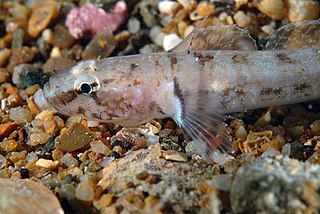
Chromogobius zebratus, Kolombatovic's goby, is a species of goby found in the Mediterranean and Adriatic Seas where they occur in shallow coastal waters. This species can reach a length of 5.3 centimetres (2.1 in) SL.
Brito's goby is a species of goby found in the Eastern Atlantic near the coasts of the Canary Islands and Madeira where it occurs at depths of from 6 to 65 metres on rock outcrops. This fish inhabits crevices in the rocks. Males of this species can reach a length of 3.4 centimetres (1.3 in) SL while females only reach 2.5 centimetres (0.98 in) SL. The specific name honours Alberto Brito Hernández of the University of La Laguna on Tenerife for his numerous contributions to the ichthyology of the Canary Islands.
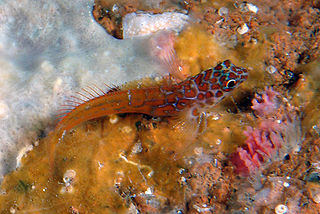
Microlipophrys is a genus of combtooth blennies found in Atlantic ocean and the Mediterranean Sea.
Juraj Kolombatović was a Croatian zoologist, best known for his work in the field of ichthyology and the Marjan hill reforestation project.

Corcyrogobius is a genus of gobies native to the eastern Atlantic Ocean and the Mediterranean Sea.
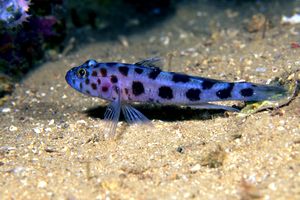
Thorogobius is a genus of gobies native to the eastern Atlantic Ocean and the Mediterranean Sea.


















